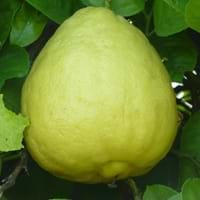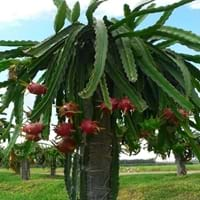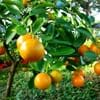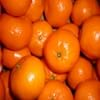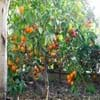Life Span
Perennial
Perennial
Type
Fruit
Cactus or Succulent
Origin
Hybrid origin, Asia
North America, Latin America and the Caribbean, Central America, South America
Types
Not Available
Not Available
Number of Varieties
Not Available
Habitat
Lawn
tropical environments, Tropical regions
USDA Hardiness Zone
11-12
Not Available
AHS Heat Zone
12-1
Not Available
Sunset Zone
H1, H2, 8, 9, 12, 13, 14, 15, 16, 17, 18, 19, 20, 21, 22, 23, 24
Not Available
Habit
Oval or Rounded
Not Available
Minimum Height
Not Available
Minimum Width
Not Available
Flower Color
White, Red, Purple
Not Available
Flower Color Modifier
Bicolor
Not Available
Fruit Color
Yellow, Yellow green
Red, Salmon
Leaf Color in Spring
Dark Green
Not Available
Leaf Color in Summer
Dark Green
Not Available
Leaf Color in Fall
Dark Green
Not Available
Leaf Color in Winter
Light Green
Not Available
Leaf Shape
Oval
Lanceolate
Plant Season
Spring, Summer, Fall, Winter
Not Available
Sunlight
Full Sun, Partial Sun
Full Sun
Growth Rate
Medium
Not Available
Type of Soil
Loam, Sand
Loam, Sand
The pH of Soil
Acidic, Neutral
Acidic, Neutral, Alkaline
Soil Drainage
Well drained
Well drained
Bloom Time
Indeterminate
Not Available
Tolerances
Drought
Deer resistant, Drought, Heat And Humidity, Salt, Shade areas, Wet Site
Where to Plant?
Ground, Pot
Container, Ground, Pot
How to Plant?
Cuttings, Grafting, Seedlings
Semi-hardwood cuttings, Stem Cutting
Plant Maintenance
Medium
Medium
Watering Requirements
Reduce watering in winter, Water frequently while growing
Water slowly, and allow to dry completely between soakings
In Summer
Lots of watering
Lots of watering
In Spring
Moderate
Moderate
In Winter
Average Water
Less Watering
Soil pH
Acidic, Neutral
Acidic, Neutral, Alkaline
Soil Type
Loam, Sand
Loam, Sand
Soil Drainage Capacity
Well drained
Well drained
Sun Exposure
Full Sun, Partial Sun
Full Sun
Pruning
Remove damaged leaves, Remove dead branches, Remove dead leaves
Dispose of diseased portions, Remove damaged leaves, Remove dead branches, Remove dead leaves, Remove dead or diseased plant parts
Fertilizers
All-Purpose Liquid Fertilizer
15-30-15 liquid fertilizer, Fertilzer with low nitrogen content
Pests and Diseases
Leafminer
Bacterial Stem Rot, Birds, Brown Rot
Plant Tolerance
Drought
Deer resistant, Drought, Heat And Humidity, Salt, Shade areas, Wet Site
Flower Petal Number
Single
Not Available
Showy Fruit
Yes
Not Available
Edible Fruit
Yes
Not Available
Fragrant Bark/Stem
Yes
No
Foliage Texture
Medium
Bold
Foliage Sheen
Glossy
Not Available
Attracts
Not Available
Not Available, pollinators
Allergy
Anaphylaxis, Oral Allergy
Not Available
Aesthetic Uses
Bonsai
Showy Purposes
Beauty Benefits
Not Available
Anti-ageing, Good for skin, Making cosmetics
Environmental Uses
Air purification
Food for animals
Medicinal Uses
Astringent, Diuretic, Febrifuge
anti-cancer, anti-inflammatory, Antitumor, Diabetes, Healing, Nutritive, Skin wounds
Part of Plant Used
Fruits, Pulp, Tree trunks
Flowers, Fruits, Seeds
Other Uses
Cosmetics, Disinfectant, Edible syrup
Cosmetics, Food for animals, Used as a nutritious food item, Used for its medicinal properties
Used As Indoor Plant
Yes
Yes
Used As Outdoor Plant
Yes
Yes
Garden Design
Container, Edible, Fruit / Fruit Tree, Houseplant, Topiary / Bonsai / Espalier, Tropical
Container, Houseplant, Rock Garden, Wall
Botanical Name
CITRUS limon 'Ponderosa'
Hylocereus undatus
Common Name
Lemon, Ponderosa Lemon
Pitahaya, Dragon Fruit
In Hindi
Ponderosa Lemon
hylocereus
In German
Ponderosa Zitrone
hylocereus
In French
Citron Ponderosa
hylocereus
In Spanish
Ponderosa Lemon
hylocereus
In Greek
Ponderosa Lemon
hylocereus
In Portuguese
Ponderosa Lemon
hylocereus
In Polish
Ponderosa Lemon
Hylocereus
In Latin
Ponderosa Lemon
Hylocereus
Phylum
Not Available
Magnoliophyta
Class
Magnoliopsida
Magnoliopsida
Order
Sapindales
Caryophyllales
Family
Rutaceae
Cactaceae
Clade
Angiosperms, Eudicots, Rosids
Angiosperms, Core eudicots, Eudicots
Tribe
Citreae
Hylocereeae
Subfamily
Aurantioideae
Cactoideae
Season and Care of Ponderosa Lemon and Hylocereus
Season and care of Ponderosa Lemon and Hylocereus is important to know. While considering everything about Ponderosa Lemon and Hylocereus Care, growing season is an essential factor. Ponderosa Lemon season is Spring, Summer, Fall and Winter and Hylocereus season is Spring, Summer, Fall and Winter. The type of soil for Ponderosa Lemon is Loam, Sand and for Hylocereus is Loam, Sand while the PH of soil for Ponderosa Lemon is Acidic, Neutral and for Hylocereus is Acidic, Neutral, Alkaline.
Ponderosa Lemon and Hylocereus Physical Information
Ponderosa Lemon and Hylocereus physical information is very important for comparison. Ponderosa Lemon height is 120.00 cm and width 150.00 cm whereas Hylocereus height is Not Available and width Not Available. The color specification of Ponderosa Lemon and Hylocereus are as follows:
Ponderosa Lemon flower color: White, Red and Purple
Ponderosa Lemon leaf color: Dark Green
Hylocereus flower color: Not Available
- Hylocereus leaf color: Not Available
Care of Ponderosa Lemon and Hylocereus
Care of Ponderosa Lemon and Hylocereus include pruning, fertilizers, watering etc. Ponderosa Lemon pruning is done Remove damaged leaves, Remove dead branches and Remove dead leaves and Hylocereus pruning is done Dispose of diseased portions, Remove damaged leaves, Remove dead branches, Remove dead leaves and Remove dead or diseased plant parts. In summer Ponderosa Lemon needs Lots of watering and in winter, it needs Average Water. Whereas, in summer Hylocereus needs Lots of watering and in winter, it needs Less Watering.
